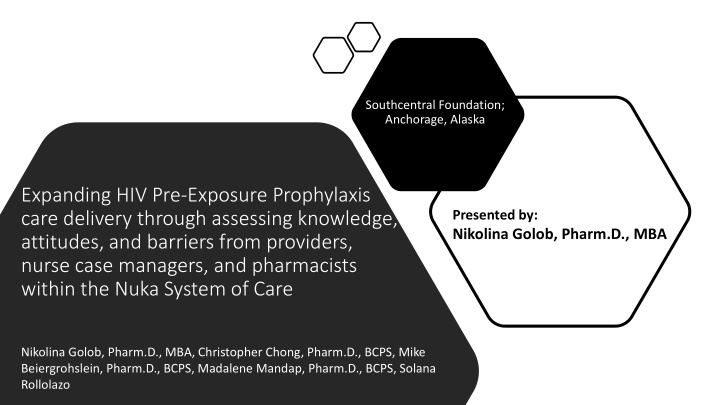



Southcentral Foundation; Anchorage, Alaska Expanding HIV Pre-Exposure Prophylaxis Presented by: care delivery through assessing knowledge, Nikolina Golob, Pharm.D., MBA attitudes, and barriers from providers, nurse case managers, and pharmacists within the Nuka System of Care Nikolina Golob, Pharm.D., MBA, Christopher Chong, Pharm.D., BCPS, Mike Beiergrohslein, Pharm.D., BCPS, Madalene Mandap, Pharm.D., BCPS, Solana Rollolazo
Obje jectives Upon completion of the program, the participant should be able to: • Describe HIV Pre-Exposure Prophylaxis and its effectiveness • Explain the role pharmacists can play in the education, initiation, and management of Pre-Exposure Prophylaxis • Discuss potential future steps Southcentral Foundation is taking to implement a pharmacist led PrEP program
Please select your professions (Select one) Provider (SCF PCC) 0.70% 2.10% 17.48% Nurse Case Manager 1.40% (SCF PCC) Provider (EIS/HIV 44.06% Clinic) Nurse Case Manager (EIS/HIV Clinic Nurse) STD Coordinator 34.27% Pharmacist
Please select the number of customer-owners who have asked you about PrEP therapy in the past year. (Select one) 0.70% 2.10% 0.70% 2.80% 3.50% 0-5 6-10 11-15 16-20 >20 90.21% Prior to this survey, I did not know what PrEP was
Discussion • Assessment/Lab Monitoring • 95% of respondents correctly responded that taking PrEP regularly for ~20 days can reduce HIV transmission up to 90% • However, only 29% of respondents correctly selected that customers should be tested for HIV annually at minimum. • Correct answer: 3 months • Barriers and Resource Utilization for PrEP Initiation and Management • Most common barriers: appointment time constraints (34%) & interruption of workflow (26%) • Most commonly utilized resources: integrated pharmacist (53%) , CDC PrEP Guidelines • Rarely/never utilized resources: HIV PrEP Pharmacy Minute (75%) & HIV PrEP Ambulatory Care PowerPlan
Discussion • Attitudes Regarding PrEP Initiation and Management • Majority of respondents felt comfortable discussing PrEP with customer- owners (75%) and monitoring customer-owners on PrEP (74%) • Most respondents were also interested in learning more about PrEP given educational materials or offered a CE course (91%) • Respondents also agreed with increasing pharmacist involvement with PrEP initiation and management (80%) • Concerns: lack of education/knowledge/training, lack of comfort and awareness of PrEP therapy, infrequency of prescribing PrEP therapy, customer-owners either lost to follow up and non-adherence to therapy.
Thank you Questions?
Recommend
More recommend